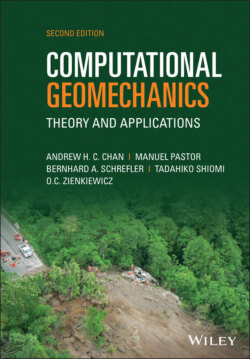Читать книгу Computational Geomechanics - Manuel Pastor - Страница 24
2.3.1 Why Is Inclusion of Partial Saturation Required in Practical Analysis?
ОглавлениеIn the previous, fully saturated, analysis, we have considered both the water pore pressure and the solid displacement as problem variables. In the general case of nonlinear nature, which is characteristic of the problems of soil mechanics, both the effective stresses and pressures will have to be determined incrementally as the solution process (or computation) progresses step by step. In many soils, we shall encounter a process of “densification” implied in the constitutive soil behavior. This means that the history of straining (associated generally with shear strain) induces the solid matrix to contract (or the material to densify). Such densification usually will cause the pore pressure to increase, leading finally to a decrease of contact stresses in the soil particles to near‐zero values when complete liquefaction occurs. Indeed, generally, failure will occur prior to the liquefaction limit. However, the reverse may occur where the soil “dilation” during the deformation history is imposed. This will imply the development of negative pressures which may reach substantial magnitudes. Such negative pressures cannot exist in reality without the presence of separation surfaces in the fluid which is contained in the pores, and consequent capillary effects. Voids will therefore open up during the process in the fluid which is essentially incapable of sustaining tension. This opening of voids will probably occur when zero pressure (or corresponding vapor pressure of water) is reached. Alternatively, air will come out of the solution – or indeed ingress from the free water surface if this is open to the atmosphere. The pressure will not then be vapor pressure but simply atmospheric.
We have shown in Chapter 1 that once voids open, a unique relationship exists between the degree of saturation Sw and the pore pressures pw (see Figure 1.6). Using this relation, which can be expressed by formula or simply a graph, we can modify the equation used in Section 2.2 to deal with the problem of partial saturation without introducing any additional variables assuming that the air throughout is at constant (atmospheric) pressure. Note that both phenomena of densification and dilation will be familiar to anybody taking a walk on a sandy beach after the tide has receded leaving the sand semi‐saturated. First, one can note how when the foot is placed on the damp sand, the material appears to dry in the vicinity of the applied pressure. This obviously is the dilation effect. However, if the pressure is not removed but reapplied several times, the sand “densifies” and becomes quickly almost fluid. Clearly, liquefaction has occurred. It is surprising how much one can learn by keeping one’s eyes open!
The presence of negative water pressures will, of course, increase the strength of the soil and thus have a beneficial effect. This is particularly true above the free water surface or the so‐called phreatic line. Usually, one is tempted to assume simply a zero pressure throughout that zone but for non‐cohesive materials, this means almost instantaneous failure under any dynamic load. The presence of negative pressure in the pores assures some cohesion (of the same kind which allows castles to be built on the beach provided that the sand is damp). This cohesion is essential to assure the structural integrity of many embankments and dams.
